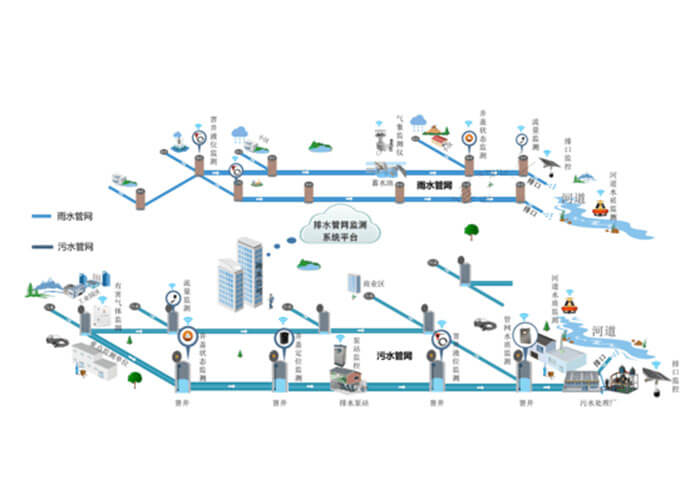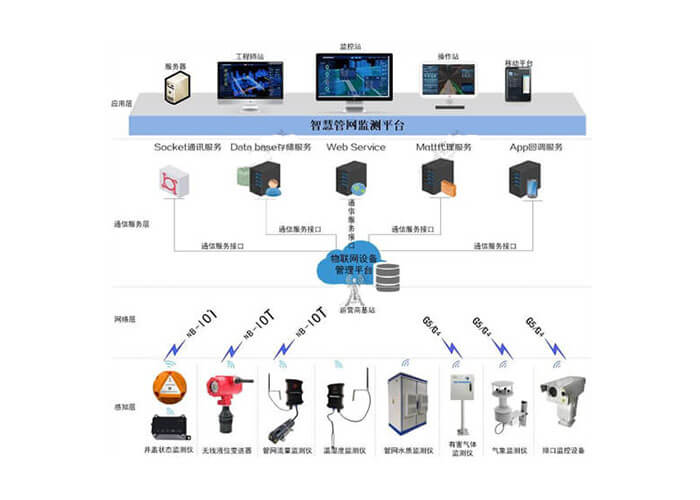
After the read, you will learn about the Smart drainage network monitoring System Solution Overview, System structure, System functions, System features.
System Overview
Through the construction of the urban smart drainage pipe network monitoring system, data collection on the status of the manhole cover of the pipe network, the liquid level of the pipe network, the flow rate of the pipe network, the harmful gas of the pipe network, and the water quality of the pipe network can be realized, and the operation status of the drainage pipe network can be grasped in real-time.
The operation scheduling, maintenance management, and rapid response of the pipe network provide effective data support so that managers can grasp the actual situation of the pipe network, can correctly deploy emergency measures in emergency situations, and continuously improve the operation and management level of the drainage pipe network.
Drainage pipe network monitoring systems are widely used in comprehensive monitoring and early warning projects such as smart drainage, smart water, smart cities, smart parks, smart ports, smart city management, smart pipe networks, urban lifelines, smart security, and safe cities.
System Structure

1. Perception layer
The perception layer is located at the bottom of the Internet of Things structure, and its function is perception, that is, to obtain perception information through the sensor network. The perception layer is the core of the Internet of Things and a key part of information collection.
2. Communication layer
The network layer is the core of data communication(Telecommunication Antennas UWB Antennas For IoT M2M Wireless Applications) and the main channel for data transmission. The network layer mainly uses communication networks such as NB-IoT(Best 4G LTE High-gain Antenna Waterproof Radome Antenna), 4G(2×2 MIMO Antenna Omnidirectional 4G LTE Antenna), and 5G(3G 4G LTE MIMO Antenna 5G Antenna For Wireless Network).
3. Service layer
The communication service layer is composed of the IoT device management platform, which realizes the collection and management of data, and provides professional and convenient data interface services for the pipeline network monitoring platform and other application platforms.
4. Application layer
The application layer is composed of a smart pipe network monitoring platform or a third-party business management platform, which implements functions such as equipment management, alarm information management, big data analysis, hydraulic model analysis, and pipe network analysis.
System Functions
1. Collection of basic pipeline information
Realize the collection of information on the location, height, attribute and other information of the drainage pipe network pipeline; collect data on the river water level elevation, groundwater level elevation, sewage treatment plant, pumping station operation status, collect regional water consumption, and standardize the pipe network information management.
2. Collection of pipe network perception data
Realize the collection of monitoring data of drainage pipe network manhole cover, realize the collection of parameters such as the status of the manhole cover, pipe network liquid level, pipe network flow, pipe network water quality (conductivity, COD, ammonia nitrogen, total phosphorus, total nitrogen, PH), and realize pipe network pumping Station operating parameters are collected and monitored to build an intelligent perception of the entire drainage network.
3. GIS monitoring
Use GIS technology to construct underground drainage pipe network pipeline planning analysis system, static sand table, etc., to realize multi-dimensional visual display of drainage system; draw three-dimensional underground drainage pipe network dynamic a picture, global perspective of the urban underground pipe network, all-round, Multi-angle and diversified dynamic display of geographic information spatial distribution.
4. Big data analysis
Through the intelligent pipeline network monitoring platform, the overall water quality, liquid level, flow, gas, etc. monitoring alarms are realized, and overflow alarms are realized; the river section data, drainage data information, sewage trend data, etc. are analyzed, and the pipeline blockage, rain and sewage confluence, Alarm and positioning for low-lying liquid level and waterlogging.
System Features
1. Professional perception equipment
Most of the equipment adopts explosion-proof, waterproof, dustproof, and other designs, combined with the actual situation of the network management to carry out professional installation plan design, most of the equipment adopts micro-power design, which can be powered by a built-in battery or externally, with long service life, simple installation and convenient maintenance.
2. Accurate distribution plan
From the plant station network to carry out the targeted and professional design of the layout plan, deploy and control corresponding equipment at each key node of branch pipes, main pipes, and main channels, comprehensively detect the operating status of the entire drainage system, and achieve full-link perspective.
3. Complete monitoring platform
Based on a sound data system, a supporting platform for data sharing, dispatching and commanding, intelligent decision-making, information release, and intelligent collaboration has been built to ensure the effective operation of the intelligent pipeline network monitoring platform, and truly realize the reporting of changes, positioning and positioning, traceable.
4. Global full link monitoring
Using the Internet of Things, big data, and cloud computing micro-service technology, we can realize all aspects of monitoring from the source, channel, and results of the drainage system to achieve refined management, business processes, intelligent inspections, assessment indicators, and intelligent decisions.
Besides the Smart Drainage Network Monitoring System Solution article, you may also be interested in the below articles.
What is the difference between WIFI and WLAN?
Summary of 41 Basic Knowledge of LTE
What Are The Advantages And Characteristics Of NB-IoT And LoRa?
What Is The 5G Network Slicing?
